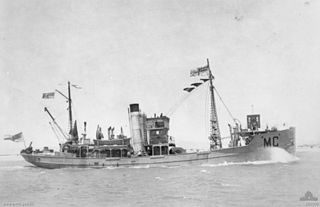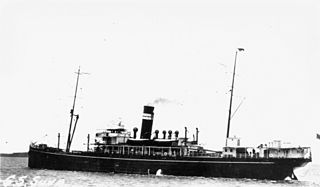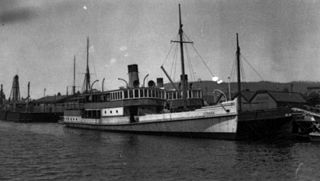
HMAS Platypus was a submarine depot ship and base ship operated by the Royal Australian Navy (RAN) between 1919 and 1946. Ordered prior to World War I to support the Australian submarines AE1 and AE2, Platypus was not completed until after both submarines had been lost, and she was commissioned into the Royal Navy from 1917 to 1919.

HMAS Bungaree was an auxiliary minelayer of Royal Australian Navy (RAN), serving during World War II. The ship was built as a cargo vessel for the Adelaide Steamship Company by Caledon Shipbuilding & Engineering Company at Dundee, and launched in 1937. The ship operated in Australian waters and was requisitioned by the RAN in October 1940. Decommissioned on 7 August 1946 and returned to her owners on 5 November 1947, she was sold in 1957 and renamed Dampier. She was then sold in 1960 and renamed Eastern Mariner and while operating in South Vietnamese waters she struck a mine on the Saigon River and was sunk on 26 May 1966. She was salvaged by a Japanese company and subsequently scrapped in 1968.

HMAS Doomba was a Royal Australian Navy (RAN) warship of World War II. Built for the Royal Navy around the end of World War I as the Hunt-class minesweeper HMS Wexford, the ship only saw two years of service before she was decommissioned in 1921 and sold to the Doomba Shipping Company. The vessel was renamed SS Doomba, converted into a passenger ship, and operated in the waters around Brisbane until 1939, when she was requisitioned by the RAN for wartime service. Serving first as an auxiliary minehunter, then an auxiliary anti-submarine vessel, HMAS Doomba was purchased outright by the RAN in 1940, and served until early 1946, when she was sold and converted into a linseed oil lighter. Doomba was scuttled off Dee Why, New South Wales in 1976.
HMAS Bermagui was a 402-ton auxiliary minesweeper operated by the Royal Australian Navy (RAN) during World War II.
HMAS Uki (FY.80) was an auxiliary minesweeper operated by the Royal Australian Navy during World War II. Laid down at Lithgows, Port Glasgow, Scotland in 1923, Uki was owned and operated by the Sydney-based North Coast Steam Navigation Company. On 3 November 1939, Uki was requisitioned by the RAN for use as an auxiliary.
HMAS Narani was an auxiliary minesweeper operated by the Royal Australian Navy (RAN) during World War II. Narani was requisitioned from the Illawarra & South Coast Steam Navigation Company as auxiliaries. The 381-ton vessel was armed with a 12-pounder 12cwt QF gun, a 20mm Oerlikon cannon, a .303-inch Vickers machine gun, and four Type D depth charges, and was commissioned into the RAN on 11 June 1941.
HMAS Bonthorpe was an auxiliary minesweeper operated by the Royal Australian Navy during World War II. She was launched in 1917 by Collingwood Shipbuilding Company at Collingwood, Ontario, Canada. Bonthorpe was owned and operated by Albany Tug Company. On 5 February 1940, Bonthorpe was requisitioned by the RAN for use as an auxiliary. She was decommissioned on 17 February 1945 and was reconverted to a trawler before becoming stranded at Cairns Inlet, Queensland in 1959.

HMAS Durraween (F93) was an auxiliary minesweeper operated by the Royal Australian Navy (RAN) during World War II. The ship was built as a trawler by Collingwood Shipbuilding Company at Collingwood, Ontario, Canada, and launched in 1918 as Seville. The ship served briefly in the Royal Canadian Navy during the last months of World War I, before being laid up and sold to a British company. In 1928, she was sold to Sydney-based fishing company and operated in Australian waters until she was requisitioned by the RAN in mid-1940 for use as an auxiliary minesweeper during World War II. Durraween operated in the Bass Strait as part of Minesweeping Group 54, and was responsible for clearing mines laid by German merchant raiders, and then later operated around the Torres Strait. She was returned to civilian service after paying off in late 1945, and was broken up in 1952.
HMAS Goolgwai was an auxiliary minesweeper operated by the Royal Australian Navy (RAN) during World War II. She was launched in 1919 by Collingwood Shipbuilding Company at Collingwood, Ontario, Canada as Almeria. The ship operated in Australian waters from 1928, and was requisitioned by the RAN on 3 September 1939. She was returned to her owners in 1945 before being wrecked near Malabar, Sydney, on 29 May 1955.
HMAS Korowa was an auxiliary minesweeper operated by the Royal Australian Navy (RAN) during World War II. She was launched in 1919 by Cochrane and Sons Ltd at Selby as Edward McGuire. The ship operated in Australian waters from 1937, and was requisitioned by the RAN in September 1939. She was returned to her owners in 1945 before being scrapped in 1954.

HMAS Olive Cam was an auxiliary minesweeper operated by the Royal Australian Navy (RAN) during World War II. She was launched in 1920 by Cook, Welton & Gemmell at Beverley as Nodzu. The ship operated in Australian waters from 1929, and was requisitioned by the RAN on 3 September 1939. She was returned to her owners in 1946 before being wrecked near Green Cape Lighthouse, Eden, New South Wales on 2 November 1954 with the loss of three lives.
HMAS Kianga was an auxiliary minesweeper operated by the Royal Australian Navy (RAN) during the Second World War. She was launched in 1922 by R. J. Lucey at Narooma. The ship operated as a coastal cargo steamer and was requisitioned by the RAN in 1941. She was not returned to her owners and was scuttled off Sydney Heads.

HMAS Mary Cam was an auxiliary minesweeper operated by the Royal Australian Navy (RAN) during World War II. She was launched in 1918 by Ritchie, Graham & Milne, Whiteinch at Glasgow as Joule. The ship operated in Australian waters from 1928, and was requisitioned by the RAN on 5 October 1939. She was returned to her owners after the war and was later scrapped in 1957.

HMAS Terka (FY.98) was an auxiliary minesweeper operated by the Royal Australian Navy (RAN) during World War II. The ship was launched as Sir Dudley de Chair in 1925 as one of the three ships used to supply the construction of the Sydney Harbour Bridge, and from 1928 operated by the Adelaide Steamship Company until she was requisitioned by the RAN in December 1940. She sank while at her moorings at Madang, New Guinea on 26 March 1945 and was abandoned.

HMAS Grantala was a hospital ship operated by the Royal Australian Navy (RAN) during World War I. She was launched in 1903 by Armstrong Whitworth Company for the Adelaide Steamship Company. The ship operated in Australian waters from 1903, and was requisitioned by the RAN on 7 August 1914. She was returned to her owners in 1915, then was sold and renamed Figuig. The ship was scrapped in 1934.

HMS Suva was an Armed boarding steamer of the Royal Navy during World War I. She was also commissioned briefly into the Royal Australian Navy before being returned to her owners. She was sold in 1928 and renamed Sirius and sold again in 1929 and renamed Bohol. An Imperial Japanese air raid on Manila in 1942 during the Second World War sank her.

HMAS Phillip was a depot tender of the Royal Australian Navy (RAN) between 1916 until 1921.

HMAS Mallina was a 3,213 GRT cargo ship built by Harland & Wolff, Belfast in 1909 as Mallina for the Australian United Steam Navigation Company for the Rockhampton to Sydney cargo route. She was requisitioned by the Royal Australian Navy in 1914, as a store carrier and collier. She was returned to her owners in 1915. She was sold in 1935 to Machida Shokai Kisen Kaisha, Japan and renamed Seiko Maru, before being sold to Kita Nippon Kisen Kaisha and renamed Siberia Maru No. 3, which was later shortened to Siberian Maru. While steaming in the Sulu Sea, Philippines on 24 September 1944, she was attacked by American aircraft of Task Force 38 and sunk with the loss of 158 of the 2,382 people on board.
HMAS Marrawah was an auxiliary minesweeper operated by the Royal Australian Navy (RAN) during the Second World War. She was launched in 1910 by Van Vliet & Company of Hardinxveld in The Netherlands. Her engines were fitted in Glasgow. The ship operated in Australian waters from 1910, and was requisitioned by the RAN on 12 December 1941. In 1943, she was transferred under the control of the US Army small ships section and allotted pennant number S-178. She was returned to her owners after the war, sold to Riverside Dock & Engineering Company and hulked. Her hulk was scuttled by the Royal Australian Air Force off Sydney on 10 May 1951.

SS Japara was a freighter of 3,323 GRT built by Mach. Fabr. & Scheepswerf P. Smit Jr., Rotterdam in 1930 and operated by Koninklijke Paketvaart-Maatschappij (KPM) in the Dutch East Indies trade. The 1930 Japara was operating with the United States Army permanent local fleet of the U.S. Army Forces in Australia (USAFIA) from 1942 until 1945 even while the larger ship, 9,312 GRT MS Japara (1938), was active in Army service oceanwide. Japara of 1930 played an important logistics role in the New Guinea Campaign.












